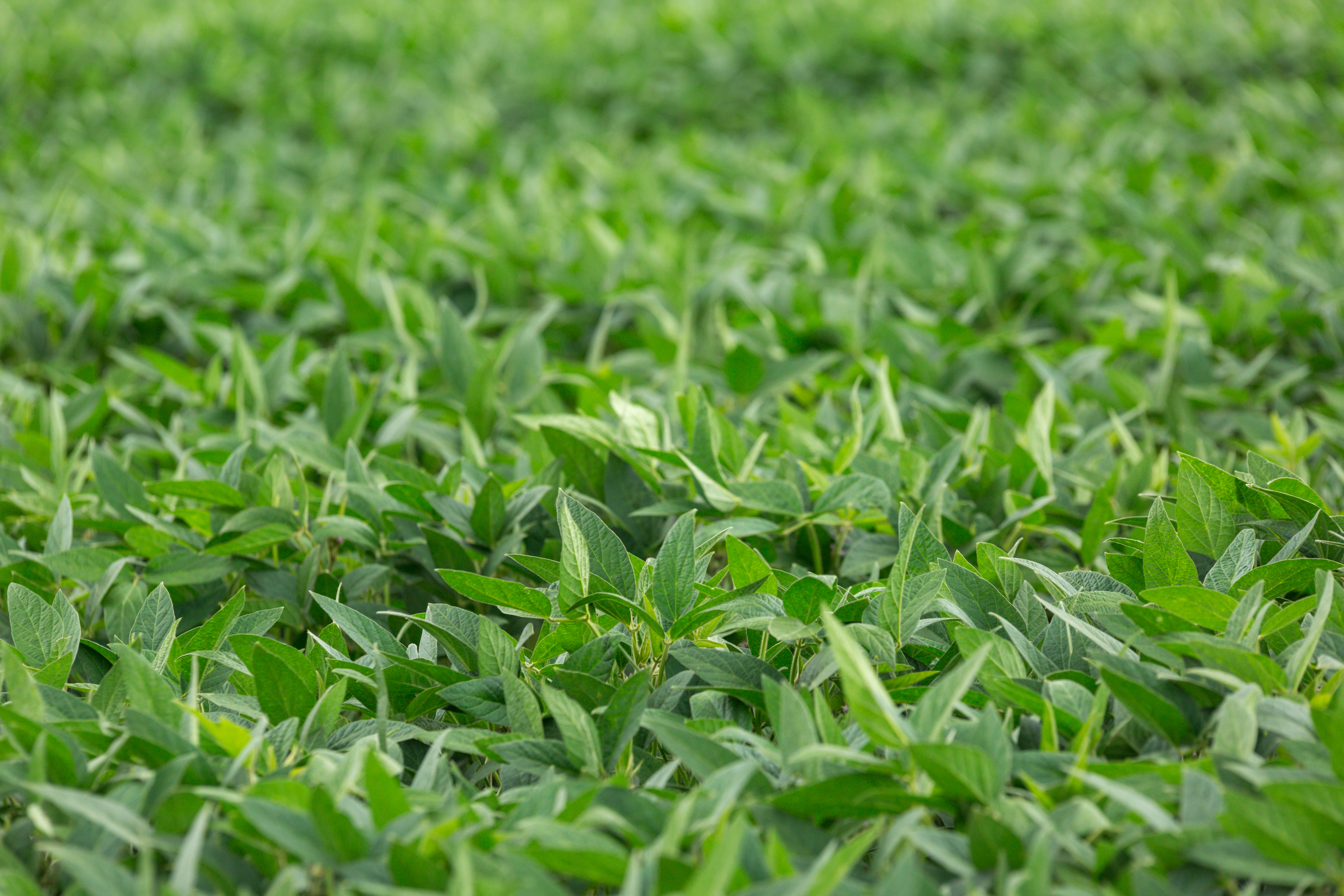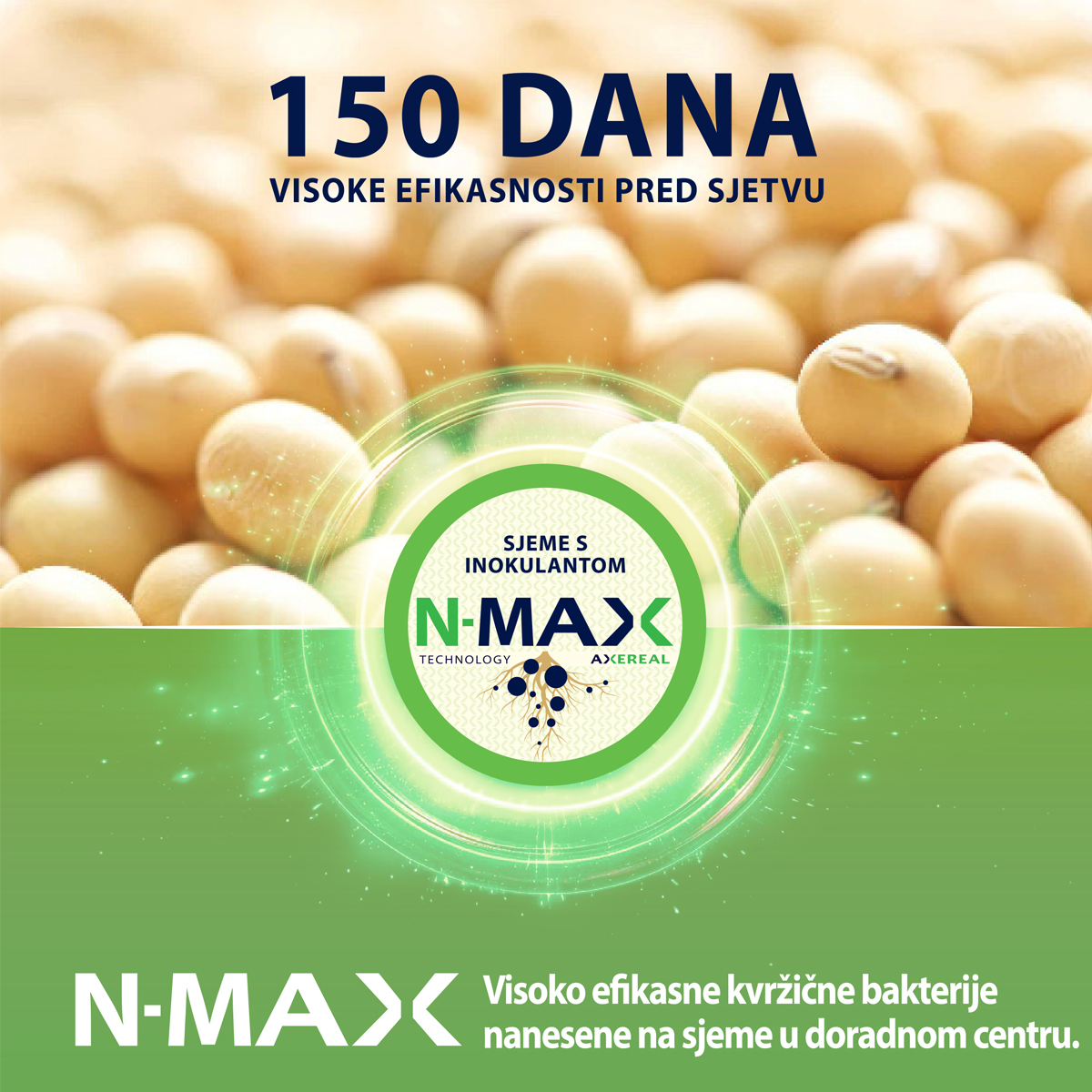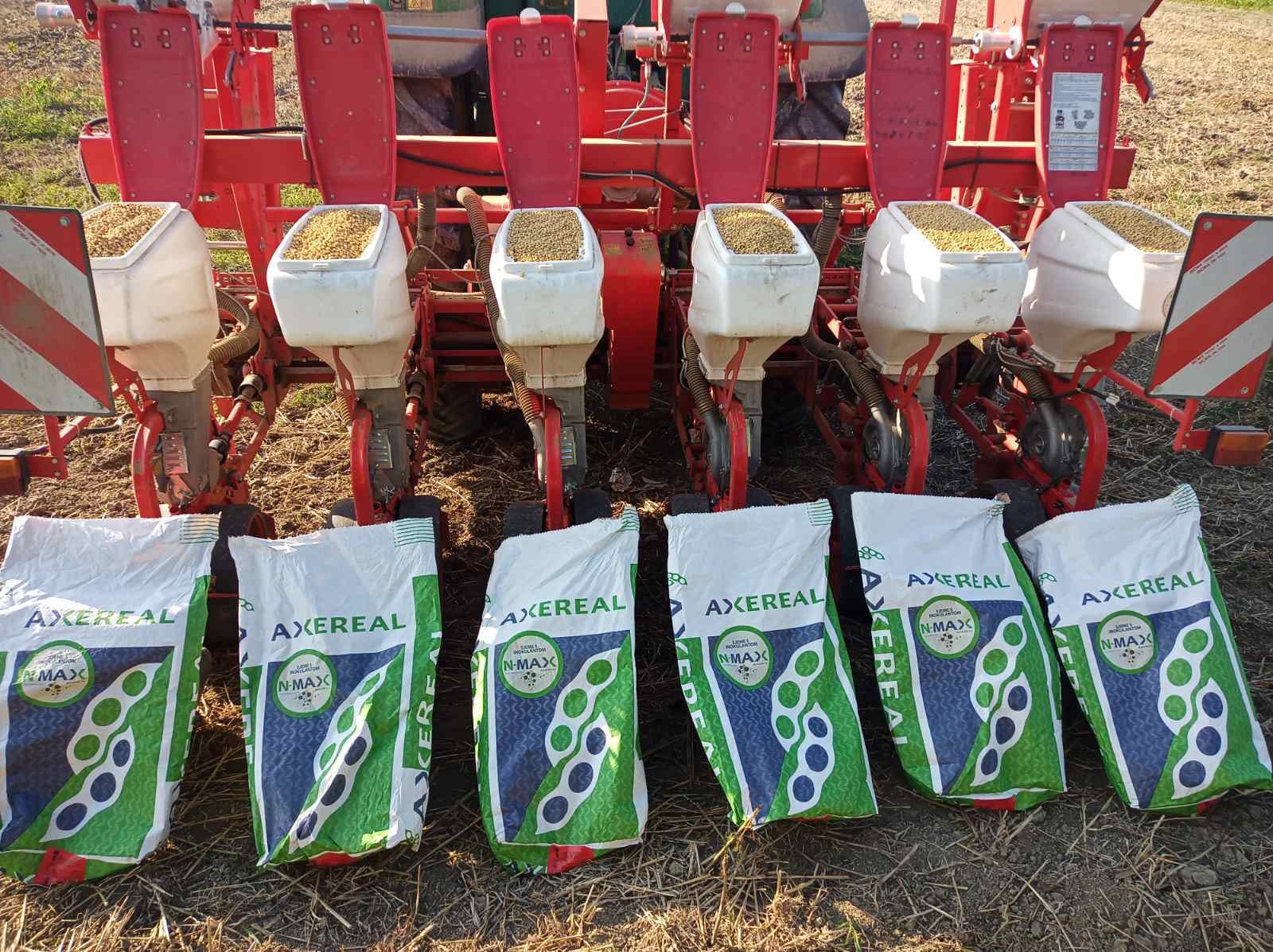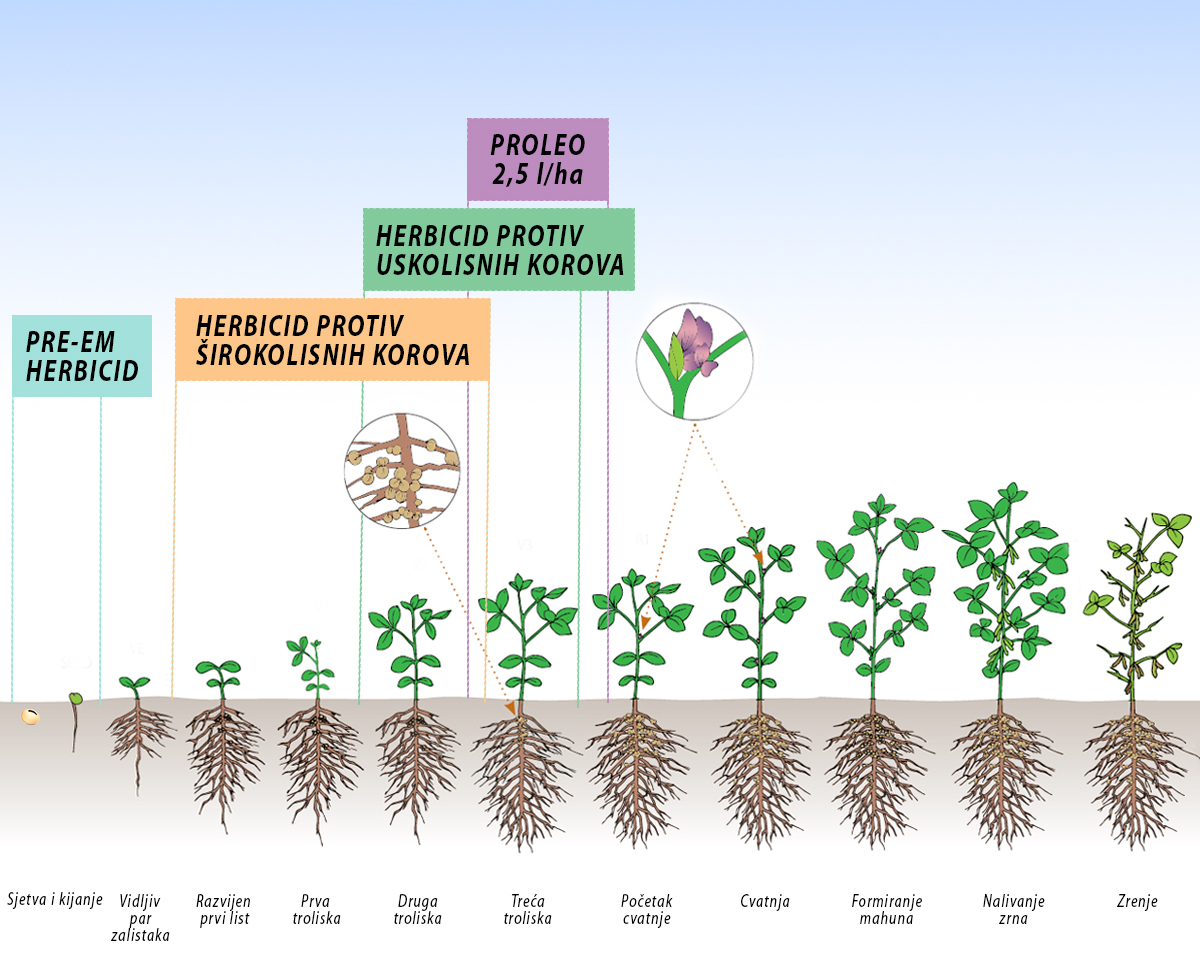Search
Soybean

Soybean serves as an excellent pre-crop for many field crops, enhancing soil structure, fixing nitrogen from the atmosphere, and offering a low carbon-to-nitrogen ratio for quick residue decomposition, all while being profitable. We offer comprehensive agronomic support to farmers from planting to harvest, supplying soybean seeds, pesticides, and facilitating the best terms for the sale of marketable crops. Below, you will find the recommended technology for successful soybean cultivation.
Land preparation and crop rotation
Small grains such as wheat, barley, rye, and triticale are excellent pre-crops for soybeans, followed by corn and potatoes, which allow sufficient time for soil preparation before sowing soybeans. Sunflowers and canola, which share common diseases with soybeans, should be avoided. Monoculture of soybeans is not recommended due to the risk of plant diseases and challenges in tillage and weed management.
During the fall, it's essential to plow the meadows to incorporate harvest residues, and plowing also helps in storing precipitation throughout the winter. At winter's end, it's important to close the furrows to retain moisture. Subsequently, employ a seed drill to break up the soil and ready the seeding layer. For uniform and high-quality germination, meticulous preparation of the sowing layer is crucial; the base should be compact, while the top layer needs to be friable. Seeds sown in such well-prepared soil meet all conditions for swift and consistent emergence. Ignoring these practices can lead to a significant reduction in crop yield.
Fertilization
For a yield of 1 ton of grain and the associated vegetative mass including roots, a soybean plant requires: 50 kg/ha of N, 40 kg/ha of P2O5, 50 kg/ha of K2O, and 10 kg/ha of MgO. Soil analysis is essential, and based on the results, fertilizers should be supplemented accordingly. Phosphorus and potassium should be applied in the fall during soil preparation. Nitrogen can be introduced at sowing time in a form that dissolves easily and quickly assimilates into the soil solution, allowing the plant to absorb it through its root system. For a rapid initial growth and sprouting, the plant needs nitrogen, which can be applied before sowing in small amounts (30-50 kg of pure nitrogen per hectare). Nitrogen fixation from the atmosphere by nodule bacteria starts approximately a month after germination (2-3 trifoliate leaves), and during this period, the plant requires nitrogen. As a legume, soy can fix nitrogen from the air, fulfilling up to 40% of its nitrogen requirement. Soybeans should be planted 3-4 years after manure application in the fields. Foliar feeding with pine has proven effective in pod setting and grain development.
Seed inoculation

Soy, as a legume, captures nitrogen from the air with the aid of symbiotic bacteria residing in root nodules. These bacteria, known as Rhizobium japonicum, must be regularly introduced into the soil via seeds. There are two methods to introduce these bacteria with the seeds:
- Inoculating the seeds prior to sowing
- N-MAX: seeds treated with inoculants effective for up to 150 days before sowing
Nitrogen fixation in nodules starts around the third trefoil stage, not before. Some of the nitrogen fixed is utilized by the soybeans, while the remainder enriches the soil for the following crop. It has been observed that small grains benefit most from the nitrogen left after soybean cultivation. If no nodules are found on the soybean roots one and a half months post-sowing, it becomes necessary to supplement nitrogen, which can include foliar application.
Sowing
The initiation of sowing is closely linked to the soil temperature within the sowing layer rather than strictly adhering to a calendar schedule. Sowing can commence when the soil temperature reaches above 12°C, with similar conditions anticipated in the subsequent days and weeks. Sowing prematurely in cold, moist soil may lead to bacterial and fungal infections in the seeds, resulting in rot and a diminished yield. Similarly, sowing too deeply, at 6 cm or more, in such conditions can have adverse effects. An optimal sowing depth is approximately 4-5 cm, and uniformity across the entire field is crucial for consistent germination.
Spacing:
The space between rows can be set at:
- 12.5 cm and 25 cm for a grain seeder
- 50 cm for a seed drill used for soybeans or sugar beets
- 70 cm for a seed drill
Each of these spacings has its benefits, which also depend on the crop variety.
Benefits of narrow row spacing (12.5 cm and 25 cm) include:
- Improved plant arrangement
- Reduced competition for water, light, and nutrients among soybean plants
- Enhanced branching in varieties that possess this trait (not all varieties can branch)
At these intervals, inter-row cultivation is not possible; only herbicidal treatments are practical.
Benefits of wider inter-row spacing (50 cm and 70 cm):
Inter-row cultivation is feasible, which is advantageous for several reasons:
- It breaks up the soil crust, preventing moisture evaporation
- It aerates the root system zone
- It controls weeds in the inter-row area, reducing the need for herbicides

Irrigation
Soy requires substantial water for its growth. During its vegetative cycle, soybeans necessitate approximately 400-450 mm of water, considering the air's relative humidity. Adequate agricultural practices and preparation before sowing help retain moisture in the seedbed, crucial for germination, emergence, and optimal crop establishment. Water remains vital throughout the growth cycle, particularly during key phenophase such as flowering and pod filling, where air humidity also plays a significant role in successful flower fertilization and pod development.
Weed control
In soybean cultivation, the most crucial practice is weed control, as weeds compete for nutrients, water, sunlight, and space. Weeds not only diminish yields but also complicate harvesting and degrade grain quality. Weed control can be achieved through two methods: mechanical control using spartan and chemical treatments.
Spartan mechanical control is feasible when the rows are spaced either 50cm or 70cm apart. The initial spartan should be conducted when the soybeans reach the third trellis stage, and the subsequent one while the field is still accessible without harming the crops. It's essential to allow a one to two-week interval after applying herbicides before proceeding with cultivation.
Weed control with herbicides
We control weeds in soybeans through two to three applications. The initial treatment, known as PRE EM, is applied after planting but before the soybeans emerge. This herbicide is distributed on the soil, and it requires a bit of rain to integrate into the soil solution. Once in the soil solution, weeds absorb the herbicide through their roots. Since soybeans are not tolerant to these herbicides, application must occur before they germinate and sprout.
The second application is performed from when the first leaves appear until just before flowering begins, often in a split application 10-15 days apart. This treatment targets broadleaf weeds.
Treatments for narrow-leaved weeds should be done separately from those for broad-leaved weeds, and these herbicides should not be mixed.
It's also crucial to consider the agents used in the previous crop, as soybeans can be sensitive to residues from some previously applied herbicides.
In periods of intense heat, it's advisable to conduct treatments in the evening to avoid the peak temperatures.

Pests
During the summer, spider mites (Tetranychus urticae) may emerge, typically starting at the edges of roads and spreading towards the field's interior. To prevent heavy infestation and rapid spread, one should use an acaricide. Often, it suffices to spray only the affected areas, and there is no need to treat the entire surface. In some years, the Painted Lady butterfly (Vanessa cardui) may also surface, feeding on soybean flower pollen before laying eggs on the plants. The hatched caterpillars then consume the soybean pods and leaves. Should there be a significant presence of these butterflies, it is necessary to apply insecticides targeting the eggs and larvae.
Harvest
Harvesting small grains is performed using a combine harvester. The harvester's speed should be adjusted based on the soybean crop's condition. Set the header as low as possible to harvest even the lowest pods. The movement speed should not exceed 5 km/h, and in weed-infested fields, it should be below 3 km/h. The ideal grain moisture at harvest time is approximately 14%. The Pallador variety may exhibit a stay-green effect in some areas, meaning that some leaves may remain on the plant during ripening while the pods are mature and the grain moisture is at 12%. It is advisable to regularly check the maturity of the pods and the moisture content of the grains.


